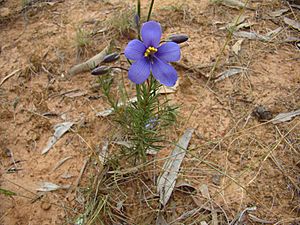Cheiranthera linearis facts for kids
Quick facts for kids Finger-flower |
|
|---|---|
 |
|
| Cheiranthera linearis | |
| Scientific classification | |
| Genus: |
Cheiranthera
|
| Species: |
linearis
|
The finger-flower (Cheiranthera linearis) is a beautiful flowering plant. It belongs to the Pittosporaceae family. This small shrub has lovely deep purple flowers with bright yellow parts inside. Its leaves are a dull green and shaped like lines. You can find it growing in parts of Australia, like New South Wales, Victoria, and Queensland.
Contents
What Does Finger-Flower Look Like?
The finger-flower is a small shrub that grows upright. It can reach about 50 cm (20 in) (20 inches) tall. Its stems are smooth.
Leaves and Flowers
The leaves grow directly on the stem. They are arranged one after another, sometimes in small groups. Each leaf is usually long and narrow, like a line. They are about 2–5 cm (0.79–1.97 in) (1-2 inches) long and 2–4 mm (0.079–0.157 in) (0.08-0.16 inches) wide. The edges of the leaves might be smooth, slightly toothed, or have small bumps.
The flowers can grow alone or in small groups of 2 to 5. They appear on short, upright stems. Each flower has five bright yellow stamens, which are the parts that hold pollen. The petals are shaped like eggs and are about 15–20 mm (0.59–0.79 in) (0.6-0.8 inches) long. They can be blue or a deep purple color.
Fruit and Flowering Time
After the flowers, the plant produces fruit capsules. These are somewhat oblong or egg-shaped and flattened. They are about 12–18 mm (0.47–0.71 in) (0.5-0.7 inches) long. You can usually see finger-flowers blooming during summer and autumn.
How It Got Its Name
The scientific name for this plant is Cheiranthera linearis. It was first officially described in 1834 by a botanist named John Lindley. The description was published in a book called Edwards's Botanical Register.
The second part of its name, linearis, comes from a Latin word. Linearis means "linear" or "like a line". This refers to the long, narrow shape of the plant's leaves.
Where Finger-Flower Grows
The finger-flower is a common plant in Australia. It grows in woodlands and forests. You can often find it in places with rocky or sandy soil. It is found across Queensland, New South Wales, and Victoria.

